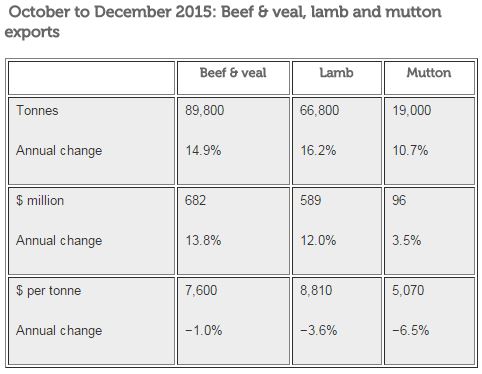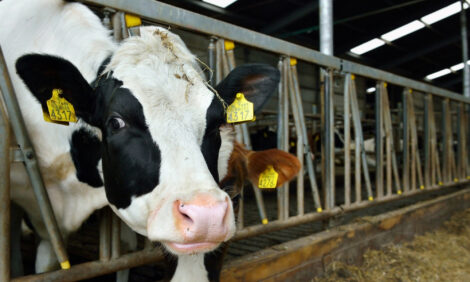



NZ Beef, Lamb Export Shipments Rise, but Returns Down
NEW ZEALAND - The first quarter of the 2015-16 meat export season concluded on 31 December 2015 and analysis by Beef + Lamb New Zealand's Economic Service shows that total red meat (including beef, veal, lamb and mutton) export revenue reached a record high over the quarter.The record was driven by increased shipments – however, average per tonne values were down, despite the New Zealand dollar (NZD) depreciation.

Beef: Strong rise in export revenue boosted by large shipments
New Zealand beef and veal exports generated $682m in the first quarter of 2015-16, up 14 per cent compared with the same period last season. This reflected a 15 per cent increase in shipments, while the average per tonne value was down 1 per cent.
Exports to North America, the largest destination for New Zealand beef and veal exports, remained unchanged compared with the previous season – at levels 33 per cent higher than the five-year average.
This mainly reflected strong demand for beef in the US. However, the average value of exports to North America was down 8.2 per cent, despite a 15 per cent depreciation of the NZD against the USD over the period. The decline reflected a 14 per cent drop in processing beef’s average value, which was partly offset by rises in the average value of other cuts.
A strong North Asian appetite for New Zealand beef and veal led to a 55 per cent increase in shipments and a 7.3 per cent rise in the average per tonne value. Beef and veal exports to North Asia totalled 31,000 tonnes from October to December 2015 – nearly equivalent to the five-year average volume exported to North America for the same period.
Lamb: Shipments up, average value down
New Zealand lamb export returns reached a record high of $589m from October to December 2015, up 12 per cent on the same period in 2014.
This reflected a 16 per cent increase in shipments, which was partly offset by a 3.6 per cent decline in the average value. The average per tonne value decline occurred despite the weaker NZD.
Demand was particularly strong in the European Union and North Asia, where shipments increased by 24 per cent and 18 per cent, respectively.
Strong demand from the European Union led to a slight improvement in the average value (+0.8 per cent) of exports to the region. However, in the case of North Asia, the rise in shipments coincided with a 16 per cent drop in the average value. This highlights the economic slowdown and uncertainties in China.
This downward trend in the average value hides differing performance for chilled and frozen lamb exports. Comparing the first quarter of 2015-16 with the first quarter of 2014-15, the average value of chilled lamb exports improved by 4.5 per cent, while the average value of frozen lamb exports dropped 8.5 per cent.
In terms of volume, chilled lamb accounted for 28 per cent of total lamb exports over both the 2014-15 and 2015-16 December quarters.
Mutton: Mutton shipments boosted by a rise in production
Mutton export returns reached a record high of $96m in the first quarter of 2015-16. This reflected a rise in shipments, which was partly offset by a decrease in the average value. Dry conditions, particularly in northern parts of the South Island, boosted mutton production and export volumes.
Mutton exports averaged $5,070 per tonne, 6.5 per cent down on the same period in 2014-15. The decrease would have been larger without the depreciation of the NZD. The largest decrease in average value occurred in North Asia, which is the largest market region for New Zealand mutton exports.
NZ farm-gate prices
New Zealand farm-gate prices for lamb and mutton dropped over the first quarter of the season following a normal seasonal decline, however the decline was greater than in previous years and was driven by:
- Dry conditions, which led to an increase in New Zealand sheepmeat production over the first quarter of 2015-16 compared with the same quarter in 2014-15;
- Weaker than expected markets, particularly for frozen exports, which resulted in lower average export receipts; and
- Weaker co-product lamb and sheep skins returns than in the same period last season.
Farm-gate prices for cattle remained at near-record high levels, after several months of increases in 2015, but are expected to start easing as US demand for beef slows down.
TheCattleSite News Desk


